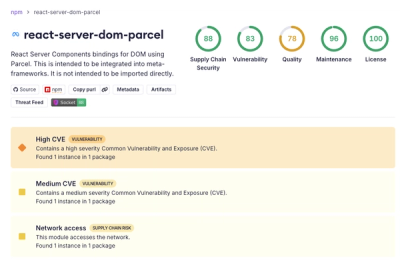
Security News
Deno 2.6 + Socket: Supply Chain Defense In Your CLI
Deno 2.6 introduces deno audit with a new --socket flag that plugs directly into Socket to bring supply chain security checks into the Deno CLI.
The main goal of p5.SVG is to provide a SVG runtime for p5.js, so that we can draw using p5's powerful API in \<svg\>, save things to svg file and manipulating existing SVG file without rasterization.
The main goal of p5.SVG is to provide a SVG runtime for p5.js, so that we can draw using p5's powerful API in <svg>, save things to svg file and manipulating existing SVG file without rasterization.
Add this line in your projects index.html :
<script src="https://unpkg.com/p5.js-svg@1.6.0"></script>
(p5.js-svg v1.6.x is compatible with p5.js v1.11.x)
Open your sketch.js and edit it:
function setup() {
createCanvas(100, 100, SVG);
background(255);
fill(150);
stroke(150);
}
function draw() {
var r = frameCount % 200 * Math.sqrt(2);
background(255);
ellipse(0, 0, r, r);
}
Then you can open your html file, and view the result. It's <svg>!

The major difference is that SVG Renderer is based on SVG Document Object Model while Canvas 2D Renderer is based on pixels. Therefore, the performance may not be as good as canvas, but SVG-format vector images can be rendered at any size without loss of quality.
Note that not all drawing results are exactly same in pixel-level.For example, the round rects below are almost same, but there are some pixels different.

As for filters, gray(), invert(), threshold(), opaque() did have same behavior as Canvas2D Renderer. But blur(), erode(), dilate() didn't.
To implement blur, feGaussianBlur was used, which is different from Processing's
blur. 
As for erode() and dilate(), they were implemnted using feOffset and feBlend.
So, the result is not exactly same. 
You can view all the pixels based diff on the online tests.
p5.js-svg@1.x was tested and should work on:
p5.RendererSVG is a class which extends p5.Renderer2D. A mocked <canvas> element and a CanvasRenderingContext2D api are provided using svgcanvas, which is JavaScript Object that syncs proprieties and draws on <svg> element.
Since SVG is XML-based, every call of the draw function will insert elements into it, and these elements keep existing even if they are not visible. So, long-time running will result in too many child elements. We recommend calling clear() in your draw function, which will trigger internal context.__clearCanvas() to remove elements.
function draw() {
clear();
// draw
}
See https://github.com/zenozeng/p5.js-svg/issues/32
To build dist files after cloning repo, you can run:
npm install
npm run build
p5.SVG was driven by tests. We use Karma and mocha. Most tests are based on pixel-diff. There are still some p5's methods not covered with unit tests. But Rendering and Shape API are already covered with tests and should work.
If you found a bug, feel free to open a issue or pull a request.
All tests can be found here: https://github.com/zenozeng/p5.js-svg/tree/master/test/unit
You can also run the online test yourself: https://zenozeng.github.io/p5.js-svg/test/
FAQs
The main goal of p5.SVG is to provide a SVG runtime for p5.js, so that we can draw using p5's powerful API in \<svg\>, save things to svg file and manipulating existing SVG file without rasterization.
The npm package p5.js-svg receives a total of 321 weekly downloads. As such, p5.js-svg popularity was classified as not popular.
We found that p5.js-svg demonstrated a healthy version release cadence and project activity because the last version was released less than a year ago. It has 1 open source maintainer collaborating on the project.
Did you know?

Socket for GitHub automatically highlights issues in each pull request and monitors the health of all your open source dependencies. Discover the contents of your packages and block harmful activity before you install or update your dependencies.

Security News
Deno 2.6 introduces deno audit with a new --socket flag that plugs directly into Socket to bring supply chain security checks into the Deno CLI.

Security News
New DoS and source code exposure bugs in React Server Components and Next.js: what’s affected and how to update safely.

Security News
Socket CEO Feross Aboukhadijeh joins Software Engineering Daily to discuss modern software supply chain attacks and rising AI-driven security risks.